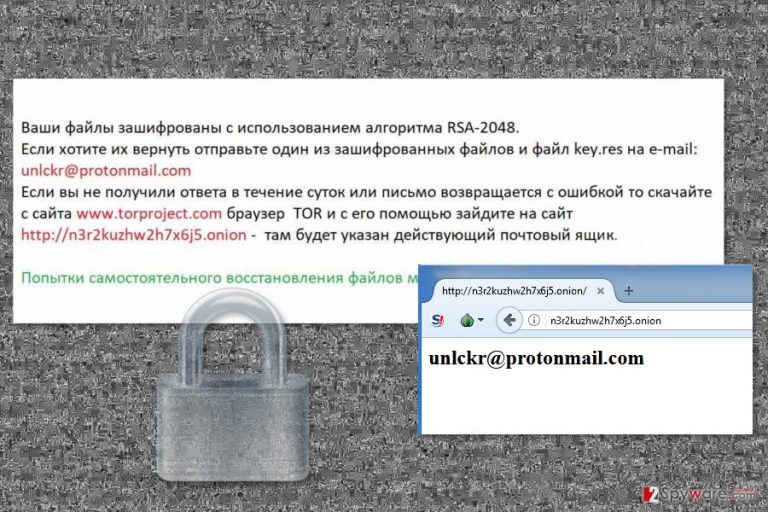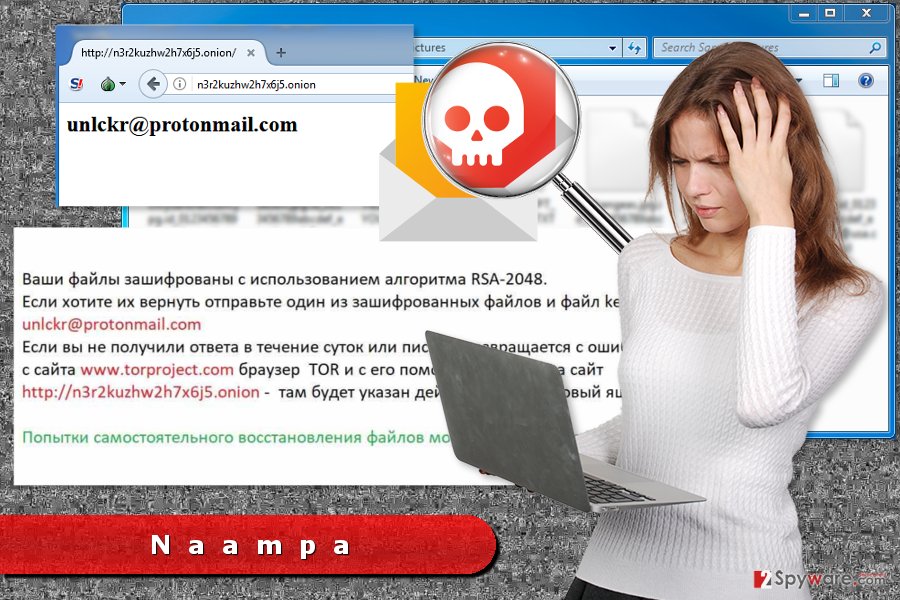Naampa ransomware / virus (Free Instructions) - Quick Decryption Solution
Naampa virus Removal Guide
What is Naampa ransomware virus?
Naampa locks personal data with .crptd file extension

Naampa is a new file-encrypting virus that employs RSA-2048 encryption algorithm to corrupt various files. It also appends .crptd extension to each of database, archive, document, audio, video or text files. Once it’s done, malware drops a ransom note called “! —- —- the README !. jpg.”
The ransom-demanding message is written in the Russian language. Thus, Naampa virus is aimed at Russian-speaking computer users.[1] Crooks ask victims to contact them via unlckr@protonmail.com email address. In the letter, they have to provide one of the encrypted files and key.res file. If victims do not receive the answer within a day, they need to check current email address via provided address using TOR browser.
Instead of communicating with cyber criminals, you should remove Naampa from the PC and try alternative recovery methods. It may not be effective and help to decrypt all of your files. But it’s the only safe option at the moment because ransomware is capable of deleting Shadow Volume Copies of the targeted files. However, criminals are not reliable people, so you should not waste your money and obtain suspicious decryption software.
According to the current data, the virus might be related to Unlock92 ransomware virus that has been attacking Russian-speaking people at the end of 2016. This crypto-malware is decryptable.[2] Thus, it’s decryptor might help to recover your files too.
Talking about characteristics of the Naampa ransomware, the virus is written in C# programming language. On the affected device malware drops two executable files – naampa.exe and mmspert.exe. These files are responsible for activating the virus and carrying out other tasks on the computer.
This cyber extortionist not only encrypts files but might cause damage to other system processes. The virus might make new entries on Windows Registry, delete or modify various sub-keys. What is more, it might affect legitimate system processes or install malicious files to complete harmful tasks. The malware creates and locates its components in these directories:
- %USERPROFILE%\Documents\!—-README—-!.jpg
- %USERPROFILE%\Documents\key.res
Deleting these files manually is not safe. Manual elimination of the ransomware might cause even bigger damage to the device. To stop malicious tasks on your computer and fix other problems on the system, you need to run professional security software, such as FortectIntego. It’s necessary for safe Naampa removal. If ransomware blocks removal tool, please check elimination instructions below the article.

Careless behavior on the Web might end up with a ransomware attack
Nevertheless, ransomware belongs to the most dangerous cyber infections; user’s participation is usually necessary to infiltrate the device. Several examples of currently active crypto-malware use exploit kits[3] and hijack devices with the help of security vulnerabilities. However, authors of not so sophisticated viruses use traditional distribution techniques that require user’s clicks:
- emails that include malicious content (button, link, attachment);
- infected ads;
- illegal downloads;[4]
- fake updates.
When you open an unknown email attachment, click on a suspicious advertisement, download illegal programs or other content or you are tricked to install a fake software update, you risk to let Naampa or another ransomware virus on your PC. Thus, be careful!
Removal steps for Naampa virus
As we have already told you, Naampa removal is performed using security software. If you do not know what malware removal tool to choose, we suggest using FortectIntego, SpyHunter 5Combo Cleaner or Malwarebytes. These professional programs will detect and delete all malicious content that might hide in your computer.
However, if you cannot install, update or run your preferred virus elimination software, you need to reboot the device to Safe Mode with Networking. This helps to disable the malware. Then you will be able to run security software and remove Naampa.
Getting rid of Naampa virus. Follow these steps
Manual removal using Safe Mode
In order to run automatic Naampa removal, follow these steps:
Important! →
Manual removal guide might be too complicated for regular computer users. It requires advanced IT knowledge to be performed correctly (if vital system files are removed or damaged, it might result in full Windows compromise), and it also might take hours to complete. Therefore, we highly advise using the automatic method provided above instead.
Step 1. Access Safe Mode with Networking
Manual malware removal should be best performed in the Safe Mode environment.
Windows 7 / Vista / XP
- Click Start > Shutdown > Restart > OK.
- When your computer becomes active, start pressing F8 button (if that does not work, try F2, F12, Del, etc. – it all depends on your motherboard model) multiple times until you see the Advanced Boot Options window.
- Select Safe Mode with Networking from the list.

Windows 10 / Windows 8
- Right-click on Start button and select Settings.

- Scroll down to pick Update & Security.

- On the left side of the window, pick Recovery.
- Now scroll down to find Advanced Startup section.
- Click Restart now.

- Select Troubleshoot.

- Go to Advanced options.

- Select Startup Settings.

- Press Restart.
- Now press 5 or click 5) Enable Safe Mode with Networking.

Step 2. Shut down suspicious processes
Windows Task Manager is a useful tool that shows all the processes running in the background. If malware is running a process, you need to shut it down:
- Press Ctrl + Shift + Esc on your keyboard to open Windows Task Manager.
- Click on More details.

- Scroll down to Background processes section, and look for anything suspicious.
- Right-click and select Open file location.

- Go back to the process, right-click and pick End Task.

- Delete the contents of the malicious folder.
Step 3. Check program Startup
- Press Ctrl + Shift + Esc on your keyboard to open Windows Task Manager.
- Go to Startup tab.
- Right-click on the suspicious program and pick Disable.

Step 4. Delete virus files
Malware-related files can be found in various places within your computer. Here are instructions that could help you find them:
- Type in Disk Cleanup in Windows search and press Enter.

- Select the drive you want to clean (C: is your main drive by default and is likely to be the one that has malicious files in).
- Scroll through the Files to delete list and select the following:
Temporary Internet Files
Downloads
Recycle Bin
Temporary files - Pick Clean up system files.

- You can also look for other malicious files hidden in the following folders (type these entries in Windows Search and press Enter):
%AppData%
%LocalAppData%
%ProgramData%
%WinDir%
After you are finished, reboot the PC in normal mode.
Remove Naampa using System Restore
This method also helps to enable the virus in order to access security software.
-
Step 1: Reboot your computer to Safe Mode with Command Prompt
Windows 7 / Vista / XP- Click Start → Shutdown → Restart → OK.
- When your computer becomes active, start pressing F8 multiple times until you see the Advanced Boot Options window.
-
Select Command Prompt from the list

Windows 10 / Windows 8- Press the Power button at the Windows login screen. Now press and hold Shift, which is on your keyboard, and click Restart..
- Now select Troubleshoot → Advanced options → Startup Settings and finally press Restart.
-
Once your computer becomes active, select Enable Safe Mode with Command Prompt in Startup Settings window.

-
Step 2: Restore your system files and settings
-
Once the Command Prompt window shows up, enter cd restore and click Enter.

-
Now type rstrui.exe and press Enter again..

-
When a new window shows up, click Next and select your restore point that is prior the infiltration of Naampa. After doing that, click Next.


-
Now click Yes to start system restore.

-
Once the Command Prompt window shows up, enter cd restore and click Enter.
Bonus: Recover your data
Guide which is presented above is supposed to help you remove Naampa from your computer. To recover your encrypted files, we recommend using a detailed guide prepared by 2-spyware.com security experts.If your files are encrypted by Naampa, you can use several methods to restore them:
Try Data Recovery Pro to restore files with .crptd file extension
Follow these steps to try Data Recovery Pro:
- Download Data Recovery Pro;
- Follow the steps of Data Recovery Setup and install the program on your computer;
- Launch it and scan your computer for files encrypted by Naampa ransomware;
- Restore them.
Take advantage of Windows Previous versions feature
This method helps to access previously saved versions of files before ransomware attack. This method works only if System Restore has been enabled before the Naampa hijack.
- Find an encrypted file you need to restore and right-click on it;
- Select “Properties” and go to “Previous versions” tab;
- Here, check each of available copies of the file in “Folder versions”. You should select the version you want to recover and click “Restore”.
Naampa decryptor is not available yet.
Finally, you should always think about the protection of crypto-ransomwares. In order to protect your computer from Naampa and other ransomwares, use a reputable anti-spyware, such as FortectIntego, SpyHunter 5Combo Cleaner or Malwarebytes
How to prevent from getting ransomware
Do not let government spy on you
The government has many issues in regards to tracking users' data and spying on citizens, so you should take this into consideration and learn more about shady information gathering practices. Avoid any unwanted government tracking or spying by going totally anonymous on the internet.
You can choose a different location when you go online and access any material you want without particular content restrictions. You can easily enjoy internet connection without any risks of being hacked by using Private Internet Access VPN.
Control the information that can be accessed by government any other unwanted party and surf online without being spied on. Even if you are not involved in illegal activities or trust your selection of services, platforms, be suspicious for your own security and take precautionary measures by using the VPN service.
Backup files for the later use, in case of the malware attack
Computer users can suffer from data losses due to cyber infections or their own faulty doings. Ransomware can encrypt and hold files hostage, while unforeseen power cuts might cause a loss of important documents. If you have proper up-to-date backups, you can easily recover after such an incident and get back to work. It is also equally important to update backups on a regular basis so that the newest information remains intact – you can set this process to be performed automatically.
When you have the previous version of every important document or project you can avoid frustration and breakdowns. It comes in handy when malware strikes out of nowhere. Use Data Recovery Pro for the data restoration process.
- ^ Bedynet. Bedynet. Russian website about computer viruses that provides malware removal tutorials.
- ^ Unlock92 Decrypter. Bleeping Computer. Website about recent computer viruses.
- ^ Exploit kits remain a cybercrime staple against outdated software – 2016 threat landscape review series. Microsoft TechNet Blogs. The new Microsoft Malware Protection Center blog.
- ^ Kayla Thrailkill. New Ransomware Targets Illegal Downloaders. PC Pitstop TechTalk. Everyday PC Tech, Tips, and Tricks.







